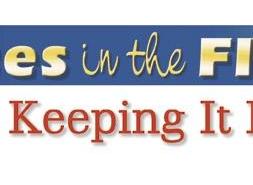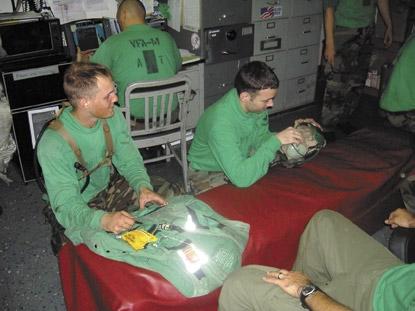
3 minute read
Best Practices in the Fleet Six Minutes for Safety: Keeping It Relevant
By ATC(AW/SW) Douglas Robertson, VFA-14

Advertisement
We have a lot of “tools” to remind us how to be safe. We have annual safety reviews, quarterly safety stand-downs, monthly safety magazines, enlisted safety-council meetings, bi-weekly newsletters, weekly editions of Safetyline, and the timeless Friday Funnies. What more could we possibly need? The answer may lie in one simple fact: Sometimes, we have to keep the message timely and relevant, minute-by-minute.
While deployed to the Arabian Gulf in support of Operation Iraqi Freedom, it became painfully evident that personnel were falling into a deep rut. Flying nearly identical flight schedules daily and going for extended

periods between port visits; we started to experience the same thing Bill Murray did in the movie “Groundhog Day.” Each day seemed to be a carbon copy of the previous one, and there was no end in sight. Talk about an environment ripe for complacency!
On deployment, we received our safety publications, and we had access to Friday Funnies and Safetyline. So, why weren’t the messages getting through? Lack of relevancy and timeliness may be the answer. Everything printed in the safety publications is relevant information; however, it did not apply to our current situation. We needed a new tool. Six Minutes for Safety was born.
Something New
The brainchild of a former squadron safety petty officer AO1(AW) Jeff Campbell and implemented by ATC(AW/SW) Douglas Robertson, Six Minutes for Safety is an innovative tool that allows constant focus on workplace safety issues.
Tied into the three-times-weekly CAG FOD/safety meetings, Six Minutes for Safety provides exactly what the name implies: a dedicated block of time for each shop to focus all attention on safety and safety-related issues. The tool is implemented at shift change, three times a week. Information from the CAG meetings may be reemphasized, or additional pertinent information can be added. The work-center LPO disseminates the information to their personnel, and it is presented in a manner to encourage discussion and feedback.
It’s the feedback that really makes the difference with this program. Previously, many personnel, especially very junior Sailors, felt they had no voice when it came to issues of safety. This program encourages all


hands to voice their concerns to their LPOs or directly to the squadron-safety representative.

What’s Included
Examples of items that frequently find their way into Six Minutes for Safety installments include: proper use and inspections of personal protective equipment (PPE), FOD walkdowns and the impact of FOD in the aviation environment, situational awareness around operating aircraft and equipment, and, last, the biggest single issue during our time in the Arabian Gulf, heat-related injuries and the importance of staying hydrated.
Many of these issues find their way into multiple installments of Six Minutes for Safety, sometimes consecutively. To prevent personnel from getting bored or ignoring repeat topics, we present the issue a different way each time, emphasizing the hazard or mindset that needs to be addressed. The idea is not to make personnel weary of any issue. While discussing any of these or myriad other issues, all hands are encouraged to offer feedback or suggestions on how to reduce or eliminate these hazards. These discussions often lead to fresh new approaches to age-old problems that we face in naval aviation.
The Benefit
The program also leads to education. Instead of a single squadron-safety representative, we have a squadron full of them. People keep their heads on a swivel and constantly are looking out for themselves, as well as their shipmates. Perhaps the greatest benefit of a program like this isn’t having a dedicated time to talk openly about safety-related issues or bragging that our squadron created a fantastic new program. Rather, the greatest benefit is that we are training up a squadron full of personnel who are confident safety observers and who are not afraid to point out an unsafe procedure or environment.
Six minutes, three times a week…a very reasonable cost for a highly effective safety program.










